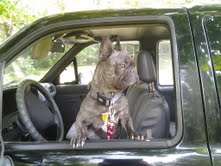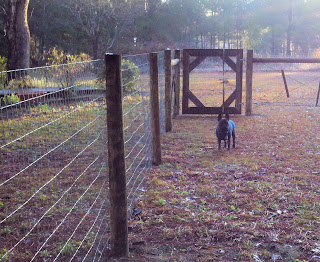Henry Inspects One of Mom's Paintings
Henry and Mom have had a whirlwind spring. Mom has been on the road doing her art stuff and Henry has held down the fort at home. It's getting too hot to go out much for Henry. He doesn't tolerate heat very well, so he will stay home for the summer months. This is his little day bed at Mom's painting studio behind the house. Most of the year he goes to Mom's Loft Studio in Gainesville, but in summer he spends more time in the painting studio. The floors are concrete and cool. He likes to get on his day bed and snooze while Mom paints. Henry somehow turned 4 years old in March. It doesn't seem possible.
Dog Safety Tips for Families- from:
Pet Peoples Place
Owning a dog can be a lot of fun, but it is also a big responsibility that cannot be taken lightly. Keeping your dog healthy and safe while also ensuring the safety of your family and other people is important. The dog safety tips for families that follow will help you to get the most enjoyment out of your four-footed friend.
Proper Dog TrainingKeeping your dog safe around other people and other dogs and animals requires that your dog is trained and socialized properly. Should your dog end up biting someone, you can be sued, fined, and arrested, depending on the laws in your state. What’s more, many states require that dogs that bite be euthanized. Learning your dog to sit, stay, heel, and so on can make a big difference in how well you can control your dog when a situation arises and the dog becomes aggressive. For example, if your dog learns to “come” when you command, then you can easily call the dog back to you if the dog runs out into the middle of the street where he might be injured by a passing vehicle, or if he charges at the delivery guy who comes to the door to bring you a package. Further, socializing the dog by taking him around a variety of people and other animals is important because it allows your dog to develop the skills that he needs to keep his cool around strangers. Socializing your dog from the time he is a puppy forward is best practice.
Restraining Your DogMost areas of the country have so-called “leash laws” that have been enacted to ensure that others are not harmed by your dog and that your dog is not harmed by hazards like traffic, other dogs, or careless people. Know and obey the leash laws and other laws regarding dogs in your area. Even if your area does not require that dogs be leashed while in public, leashing your dog is invariably a good idea when you are out and about. It will keep your dog from running off while also helping you to maintain control of the dog. Most vets recommend a standard retractable leash with around a six foot lead. Learn how to safely use the leash and use it each time you take your dog out.
Enclosures for Your DogRetraining your dog while outdoors might also involve the use of outdoor enclosures. It is never a good idea to leave your dog tethered outside all day long, alone. This can lead the dog to become overly aggressive and in some locations, it is illegal to do so. Outdoor cables or tie-outs are also potentially dangerous to the dog as the dog can become entangled in this type of contraption and become choked or asphyxiated. A better outdoor enclosure for your dog’s safety and to keep him properly restrained is an outdoor fence enclosure or dog run. But even with the use of this type of enclosure, always supervise your dog when he is outside. Depending on where you live in the U.S., you may need to provide more extensive enclosures when your dog is outside. For instance, if you live in Ohio, certain dog breeds, like the pit bull or Rottweiler, are required to be confined in a fenced in yard with a locking gate. Check with your local animal control officer if you are unsure about what is required in your area.







